Much has been written--and quite a bit of it by me--regarding the correct angle at which the left hand fingers should approach the neck and the fingerboard. Ideally, the fingers would apply pressure to the strings (and fretboard) at an absolute ninety degree angle. Well, that would be ideal in a perfect world. In case you hadn't noticed... Here in the real world, we work within the constraints given us.
Take a look at the picture above. This is what is considered just about the best that one can hope for. Note that the thumb is placed behind the fingerboard, not draping over the top and impeding the sixth string. Nor is it crawling around the opposite side of the neck -- it is right on the centerline of the neck. The second and third finger are each covering a fret, in this case the sixth and seventh fret. In the aforementioned perfect world, the first finger and fourth finger would also be perpendicular to the fretboard whilst doing a manly job of covering the fifth and eighth frets, but it is plain to see they are beginning to lean over to do their job, the lazy sods. This is typical to a greater or lesser extent with every guitar player's hand. Don't expect too much more. What is important is that the fingers are properly arched and not impeding the vibration of any adjacent strings. You can't tell by the photo but the fingers are all on the fourth (or D) string. The third (or G) string can be plucked and will vibrate cleanly even though the entire hand is camping out on the fourth string.
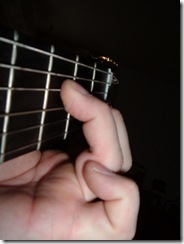 When a new student tries to form that famous open position F major chord, what will often happen is that in the attempt to flatten the first finger to cover the C and F on the first fret second and first string, the other two fingers (second and third) collapse or lose their arch. In the picture to the left you will note that although the third finger is successfully depressing the F on the fourth string, third fret, the fat little finger pad is also leaning all over the third string which will result in that fretted A on the third string will sound like Aunt Tilly after a bowl of chili. And even if you can't even hear the A note flubbing around, the result is still a stinker!
When a new student tries to form that famous open position F major chord, what will often happen is that in the attempt to flatten the first finger to cover the C and F on the first fret second and first string, the other two fingers (second and third) collapse or lose their arch. In the picture to the left you will note that although the third finger is successfully depressing the F on the fourth string, third fret, the fat little finger pad is also leaning all over the third string which will result in that fretted A on the third string will sound like Aunt Tilly after a bowl of chili. And even if you can't even hear the A note flubbing around, the result is still a stinker!
Chances are, repositioning the thumb a bit lower on the back of the neck will increase the arch of the second and third finger allowing the chord to sound more cleanly. BUT this is only the case if the first finger can still remain nice and flat on the second and first strings! This is why guitar teachers such as myself will harp on finger-independence.
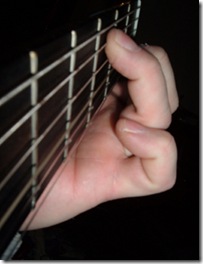 Alright. Now we've seen what it looks like when done poorly. The photo to the left shows the same chord from the same position, but the fingers are arched enough to result in a clean chord from stem to stern. It is not all that much of a difference that takes one from chump to champ. You've got to really study the image to see the difference -- and it ain't just the slight variation in camera angle, bucko.
Alright. Now we've seen what it looks like when done poorly. The photo to the left shows the same chord from the same position, but the fingers are arched enough to result in a clean chord from stem to stern. It is not all that much of a difference that takes one from chump to champ. You've got to really study the image to see the difference -- and it ain't just the slight variation in camera angle, bucko.
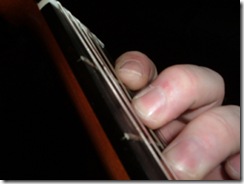 Here -- to the right -- we see that F chord again from the player's vantage point. What will it look like from the driver's seat when executed with aplomb? Trust me, the second and third fingers are arched. You can plainly see that the first finger is flat. This chord will ring with all the beauty that an F chord in the open position can muster. Yeah, it ain't my favorite -- give me the big Grand Barre any day of the week! Down with poxy, baby, open chords! That's just a joke folks.
Here -- to the right -- we see that F chord again from the player's vantage point. What will it look like from the driver's seat when executed with aplomb? Trust me, the second and third fingers are arched. You can plainly see that the first finger is flat. This chord will ring with all the beauty that an F chord in the open position can muster. Yeah, it ain't my favorite -- give me the big Grand Barre any day of the week! Down with poxy, baby, open chords! That's just a joke folks.
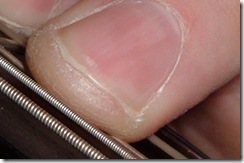 Hey, have a look at this beauty! Nice pink nail beds, no fungus infections, nothing ingrown, fairly new set of strings... No, that's not what to notice. The finger tip is cleanly depressing the fourth string, while the fifth and third string are not being affected at all. And with those huge food-hooks, if I can do it, anyone can. (And take a look at that picture -- it's almost finger pornography, isn't it?) Well, you can note the fingernail on that zeppelin for one piece of fatherly advice. Please notice how far down I've cut my nails. I don't bite them, but people think I do. Long nails (sorry ladies, they have to go if you're a player) are a hazard to clean fretting. Not only do they force you to exert greater pressure to get your finger pad onto the string, you'll also dig little pits in your fingerboard that will require major surgery to correct at a later date, plus you'll sound all tick-tacky to boot.
Hey, have a look at this beauty! Nice pink nail beds, no fungus infections, nothing ingrown, fairly new set of strings... No, that's not what to notice. The finger tip is cleanly depressing the fourth string, while the fifth and third string are not being affected at all. And with those huge food-hooks, if I can do it, anyone can. (And take a look at that picture -- it's almost finger pornography, isn't it?) Well, you can note the fingernail on that zeppelin for one piece of fatherly advice. Please notice how far down I've cut my nails. I don't bite them, but people think I do. Long nails (sorry ladies, they have to go if you're a player) are a hazard to clean fretting. Not only do they force you to exert greater pressure to get your finger pad onto the string, you'll also dig little pits in your fingerboard that will require major surgery to correct at a later date, plus you'll sound all tick-tacky to boot.
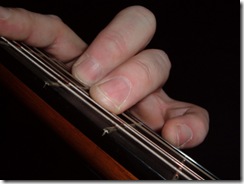 Here is a d minor 7 chord played at the fifth fret. It's a Grand Barre form. Note the flat first finger, the second and third more or less on-axis for a perpendicular approach, the fourth finger is a bit splayed to catch the C on the first string. Remember what I said about an imperfect world? The fourth finger can slack it here as it isn't interfering with any fretted pitches. Looks like crap though, doesn't it? Look at the ideal position in the first photo on this page. You will see that the fourth finger is also a bit skewed. Look at your own fourth finger. I can guaranty that the actual callous on the finger is off to the trailing edge side of the finger pad. Am I right? It's like this for everyone. Correct finger position is a Holy Grail that we seek and search for with the full knowledge that we will never attain or goal -- but we must continue in the direction of perfection.
Here is a d minor 7 chord played at the fifth fret. It's a Grand Barre form. Note the flat first finger, the second and third more or less on-axis for a perpendicular approach, the fourth finger is a bit splayed to catch the C on the first string. Remember what I said about an imperfect world? The fourth finger can slack it here as it isn't interfering with any fretted pitches. Looks like crap though, doesn't it? Look at the ideal position in the first photo on this page. You will see that the fourth finger is also a bit skewed. Look at your own fourth finger. I can guaranty that the actual callous on the finger is off to the trailing edge side of the finger pad. Am I right? It's like this for everyone. Correct finger position is a Holy Grail that we seek and search for with the full knowledge that we will never attain or goal -- but we must continue in the direction of perfection.







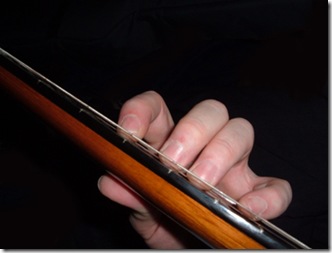



2 comments:
I'm a left hand, and til now, it has been a bit difficult to learn how to play the guitar because of everybody is right handed, so that makes it difficult to teach me. But there are ways to overcome troubles, for example viagra online helps people on troubles
Post a Comment